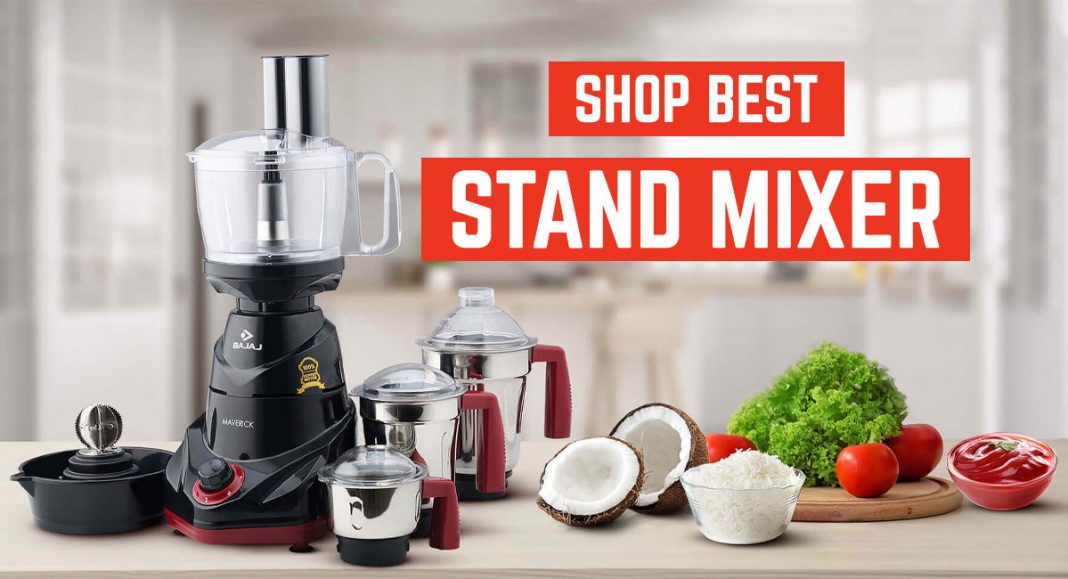There comes a time in the life of many ambitious cooks when they start to want a KitchenAid stand mixer. The aspirational machine is a standby in both amateur and professional kitchens, automating tedious tasks like kneading and whipping—and often producing better results than anything you could achieve by hand.
The stand mixer is widely considered a baker’s tool, thanks to the whip, paddle, and dough hook that come standard in every box. But once you’ve taken the leap and dedicated a section of your counter or cupboard to this sizable multitasker, there’s a whole world to explore. That’s because in addition to kneading dough for 20 minutes and frothing flawless foams, a stand mixer has the potential to be an everyday workhorse, thanks to KitchenAid’s catalog of proprietary attachments. They work with the mixer’s sturdy motor to automate tasks you might otherwise do manually or with a separate machine, such as shredding, grinding, slicing, peeling, coring, and sifting. Some also open the door to culinary hobbies, like making sausage or pasta from scratch, broadening the types and quality of dishes that can come out of your kitchen.
But not all of KitchenAid’s three dozen or so attachments are worth the cupboard space. And with prices ranging from $50 to $200, they’re not always the cheapest way to achieve your goal. After scanning all of the options (and having tried out a couple in the past), we picked five of the most-useful-looking attachments to test and found a few we’d recommend. These attachments equip you with new ways to use a machine you may already own, and they make it easy to fearlessly level up your skill set and conquer new recipes. You can do everything from rolling wonton skins to shredding a mountain of cheese. And with the food grinder attachment, you’ll know exactly which cuts of meat are in your burger. Also, they may actually save you space by allowing you to rely on the same powerful motor for all of these tasks, rather than having to find room to store several heavy appliances.
Get this if: You frequently cook with ground meat and want to control the quality, or you want to start making your own sausage.
Whether you’re making hamburgers or meatloaf, using store-bought ground meat is undoubtedly the most convenient approach. But there are many compelling reasons to grind your own. For one, it gives you total control over what cuts go into your custom blend. Also, if you’re concerned about the transparency of where your ground beef comes from, processing it yourself takes care of that, too. KitchenAid’s Metal Food Grinder Attachment makes grinding your meat swift and easy.
Admittedly, this was the attachment I wanted to try the most because I’ve always been interested in making my own charcuterie. Though I haven’t yet developed the sausage- and pâté-making practice I had imagined, I was struck by how often I was willing to reach for the grinder just to produce freshly ground meat for all the same foods I was cooking before.
The three different grinding plates that come with this attachment allow you to customize the coarseness, depending on the application, and to achieve a more-precise texture than a food processor could. It’s a lot like the difference between a burr grinder, which mills coffee into even pieces, and a blade grinder, which chops indiscriminately.
The largest die gave an evenly rough texture to a cut of steak for tartare. It was a lot more efficient than hand-chopping, particularly because I could pre-chill the metal attachment and not have to worry about my hands warming the meat. Using the medium die, I ground a blend of pork and beef cuts for meatballs. And because I was able to grind the two together, I didn’t have to manipulate the meat as much during mixing; less manipulation is said to be the trick to tenderness. As a result, the overall flavor in the final product was better than anything I’ve achieved with store-bought mince. The grinder also comes with a nozzle and an attachment for making sausage, though I didn’t get around to stuffing the 4 pounds of chorizo I ground into links.
Since all of the parts are metal except for the sausage-stuffing nozzle, you can chill the whole attachment in the freezer to keep whatever you’re grinding as cold as possible; this keeps the meat firm and pathogen-free during processing. The grinder maintained a steady clip while it ran for five minutes or so, and the motor on my KitchenAid Pro 600 mixer didn’t get hot by the end of the process.
Although a decent standalone meat grinder can be had for about the same price as this accessory, it is essentially a motor with the same auger-and-die mechanism as the KitchenAid attachment. As much as I enjoy cooking with freshly ground meat, I can’t imagine buying a separate machine, unless I had a much larger kitchen and a lot more meat that I needed to process. Until I start a restaurant from my apartment or pick up hunting, I prefer and appreciate the added functionality (as well as the warranty) of the appliance I already have.
Flaws but not dealbreakers: The grinder will leave about an ounce of meat scraps that don’t get pushed through the die, but here’s a chef’s trick you can use: Scrunch some plastic wrap into a strip, and drop it into the hopper behind the last bit of meat. It will wind through the gear and push the meat through, leaving the plastic behind, neatly wrapped around the auger.
Pasta sheet roller
Get this if: You prefer fresh pasta over dried, or you just want to level up your cacio e pepe every time.
Silky, fresh pasta made from scratch is well worth the effort. And for something fashioned only from flour and eggs, it’s deceptively luxurious. But if you’re working alone using a hand-crank machine, it can be hard to coordinate your actions for the necessary step of rolling out the pasta dough again and again. The KitchenAid Pasta Roller attachment simplifies the job of making pasta sheets by automating the roller, which frees your other hand to focus on guiding the pasta dough through and keeping it from tearing or going off-track. Even accounting for a 30-minute rest time, with some practice, you can comfortably have fresh pasta in about an hour using this attachment.
I made several batches of pasta dough using Samin Nosrat’s recipe, which is yolk-rich and particularly smooth to roll out. I also tried noodles made with bread flour—which produces a tougher dough and chewier noodles, like ramen or udon—to make sure the motor and roller could stand up to the task with a wide range of doughs. Compared with the soft, all-purpose flour dough, the bread-flour dough was harder to work with, drying out faster and taking longer to roll out (but that would be the case with any roller). Even with the slower pace of this attachment, using it was still preferable to hand-rolling (which makes achieving thinner sheets much more difficult, particularly for the unskilled).
At the time of testing, none of the pasta-cutter attachments were available for me to try, but I had no problem hand-cutting my pasta sheets into noodles. If anything, the irregularity added some bespoke character to my dishes. According to KitchenAid, the roller and cutter come from the same Italian manufacturer, so the implied promise is that the quality of the cutter attachments should be up to the same standard as the roller I tested.
I love that I can make great pasta on a whim with this attachment, and it’s really ideal for entertaining, too. Nothing is as elegant as a freshly sauced pappardelle. And thin, delicate layers of pasta make the biggest difference in lasagna, whether you’re serving it to a crowd or freezing one to give away later. Pro tip: There’s no need to boil the noodles beforehand.
Hand-crank pasta rollers run from about $30, on the low end, to $100, for a heritage brand like Marcato. But they are clunky, with many parts, and potentially destined to become forgotten in the back of your cupboard. The KitchenAid Pasta Roller attachment, which is priced on a par with a nicer manual roller, is easy enough to operate that you might reach for it on any day—not just when you’ve carved out the time for a project.
Flaws but not dealbreakers: It’s noisier than a manual roller, but that’s a small price to pay to be able to have your hands free to control the pasta dough without help from a sous chef. The steel roller is prone to rusting and shouldn’t be cleaned with water, but that’s something most pasta rollers have in common. For maintenance, all you have to do is use the included brush to dust any excess flour off the rollers after using. KitchenAid also recommends greasing the roller with mineral oil every 50 or so uses, to prevent rust and maintain optimal function.
Slicer/shredder
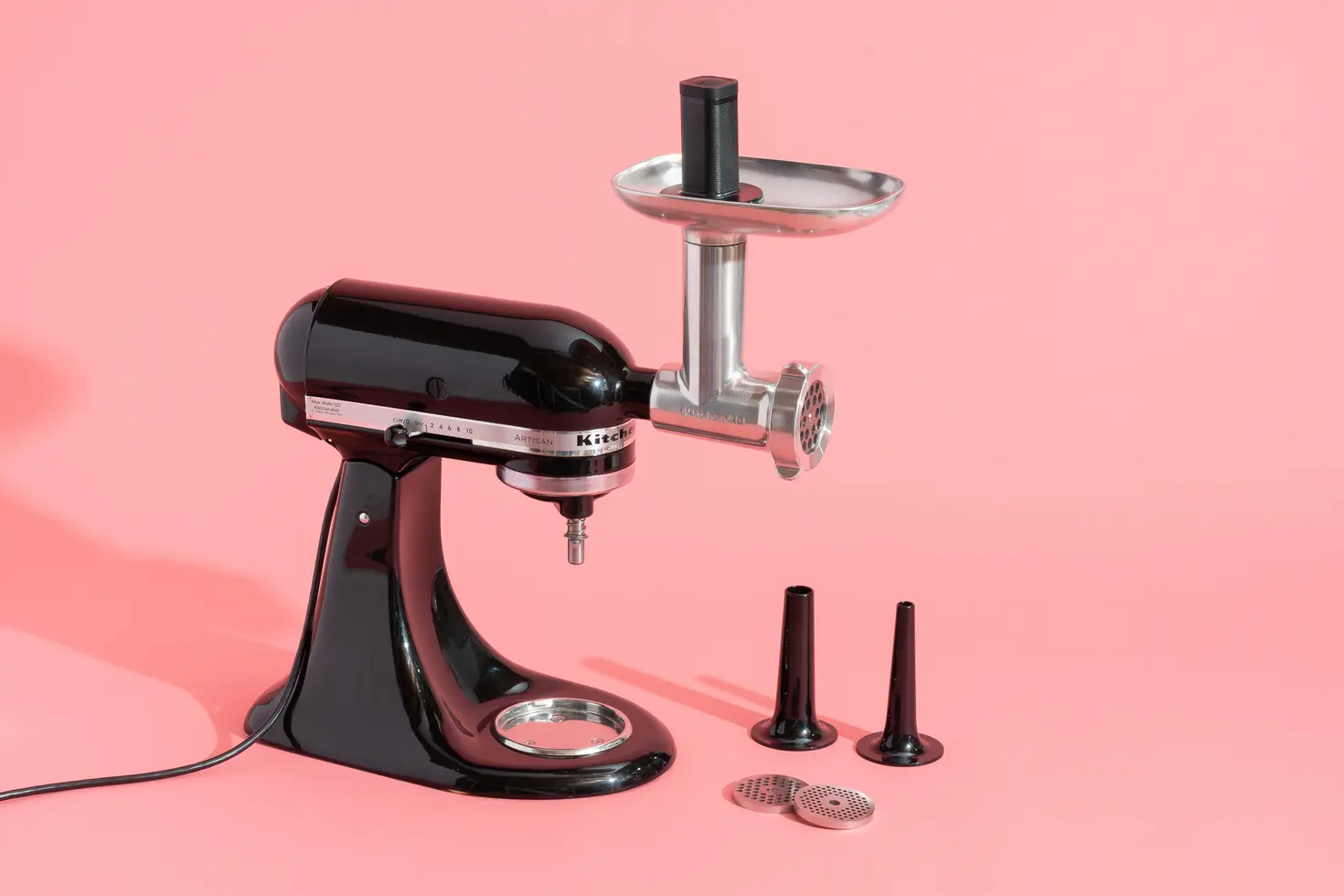
Get this if: You cook with copious amounts of cheese or frequently cook for a crowd but don’t own (or want to own) a food processor.
The KitchenAid Fresh Prep Slicer/Shredder Attachment is a handy attachment for tackling everyday grating and slicing, and it can minimize the amount of time it takes to prepare things like macaroni and cheese, pizza, and salads. When you’re short on time, the allure of pre-grated cheese and shredded vegetables is strong, but there’s no denying that the quality is compromised. In order to maintain fluffy, separate shreds, bagged grated cheese is usually coated in starch or other anti-caking agents, and vegetables simply dry out. So being able to do your own prep is a great way to maintain the taste and integrity of your meals.
In testing, I shredded 5 pounds of potatoes and a pound of carrots with ease, stopping only to clear the grater from time to time, since it has a tendency to trap things. Cabbage was a little harder to grate because the opening of the attachment isn’t very wide, and the narrow wedges I tried to run through would not shred completely. I also tried grating a pound each of cheddar, mozzarella, and Romano cheeses. The cheddar and Romano did well, but the mozzarella was a little soft and benefited from an initial 15-minute freeze to improve the results. Overall, I thought the attachment worked well, but I never found myself reaching for it over my coarse microplane or even a knife and cutting board.
But do you need it? That depends. Most food processors come with graters and can handle larger batches, plus they have a built-in receptacle to catch your shredded ingredients. They also have a bigger opening and can handle whole potatoes and large wedges of cabbage, which were a no-go for this attachment. For smaller batches, a box grater or mandoline can do the same job and leave you with fewer things to wash afterward. This attachment is for those who are in between—people with a KitchenAid stand mixer who don’t want to acquire a food processor but who want an automated way to shred and slice.
Flaws but not dealbreakers: After grating carrots, the white plastic body of the Slicer/Shredder was briefly stained and required a couple minutes of focused scrubbing to fully lift the color. Something like fresh turmeric or beets could cause permanent staining, especially if you don’t deal with it right away. Additionally, collecting the shredded food can be a little messy, since the attachment is so high up that there’s a tendency for some bits of food to be propelled beyond the circumference of most bowls that fit underneath it. The best receptacle is a tall bowl with a smaller base so it can fit flush against the base of the mixer.
Attachments we don’t recommend
KitchenAid Gourmet Pasta Press: Too much fuss
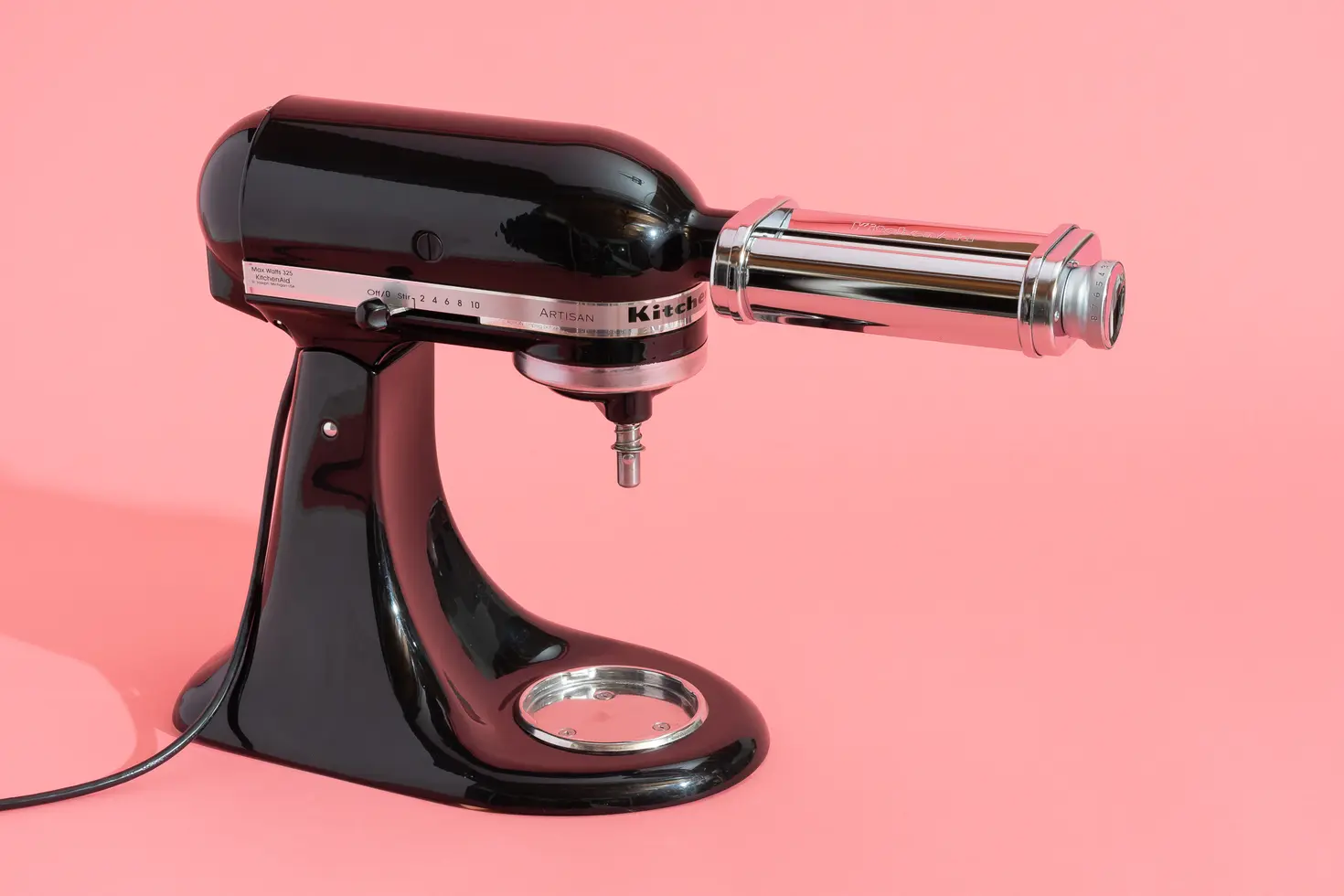
Unlike the pasta roller mentioned above, the KitchenAid Gourmet Pasta Press is a pasta extruder. To use it, you load the hopper with dough, which is churned by an auger through a die to make your desired shape. This is the method by which tubular pasta like rigatoni and bucatini is made, and this attachment comes with six dies to achieve those shapes, as well as fusilli, large and small macaroni, and spaghetti.
Industrial pasta extruders are powerful machines with dies cast in bronze or brass to handle the stiff semolina and water doughs that are typically used for dried pasta production. The KitchenAid attachment, on the other hand, felt a little like using a Play-Doh play set. The plastic construction left something to be desired, and the results were irregular. My elbows had no bend, and the pasta had a hard time keeping its shape if it wasn’t cooked immediately.
The pasta itself was tough and too thick, and it also took a really long time to cook. I found the result absolutely not worth the effort in the case of a rigatoni in pomodoro sauce I made the first night. However, the thicker pasta worked well in baked macaroni and cheese, where the blanched noodles were able to fully soften and made for a really decadent version of that dish. Still, I can’t imagine having this attachment around just for that purpose.
Those were the results I got using the dough recipe included in the manual. Though I had designs on eventually trying a high-protein ramen dough on the spaghetti setting, my first tests did not inspire confidence that the attachment could handle something tougher. Some online reviews suggest alternative recipes, but the parts (especially the dies) were so tedious to fully clean between uses that I decided against experimenting further with the machine.
Another issue with this attachment: Even though a batch of pasta takes only about 15 minutes to make, the work is incredibly active. There were times I wanted someone to help me coordinate the two actions of keeping the hopper loaded with dough and cutting the pasta to size. This involved using a harp strung with a cutting wire attached to the end of the extruder—a constant job that is hard to multitask around.
KitchenAid All Metal Grain Mill: Loud and inefficient
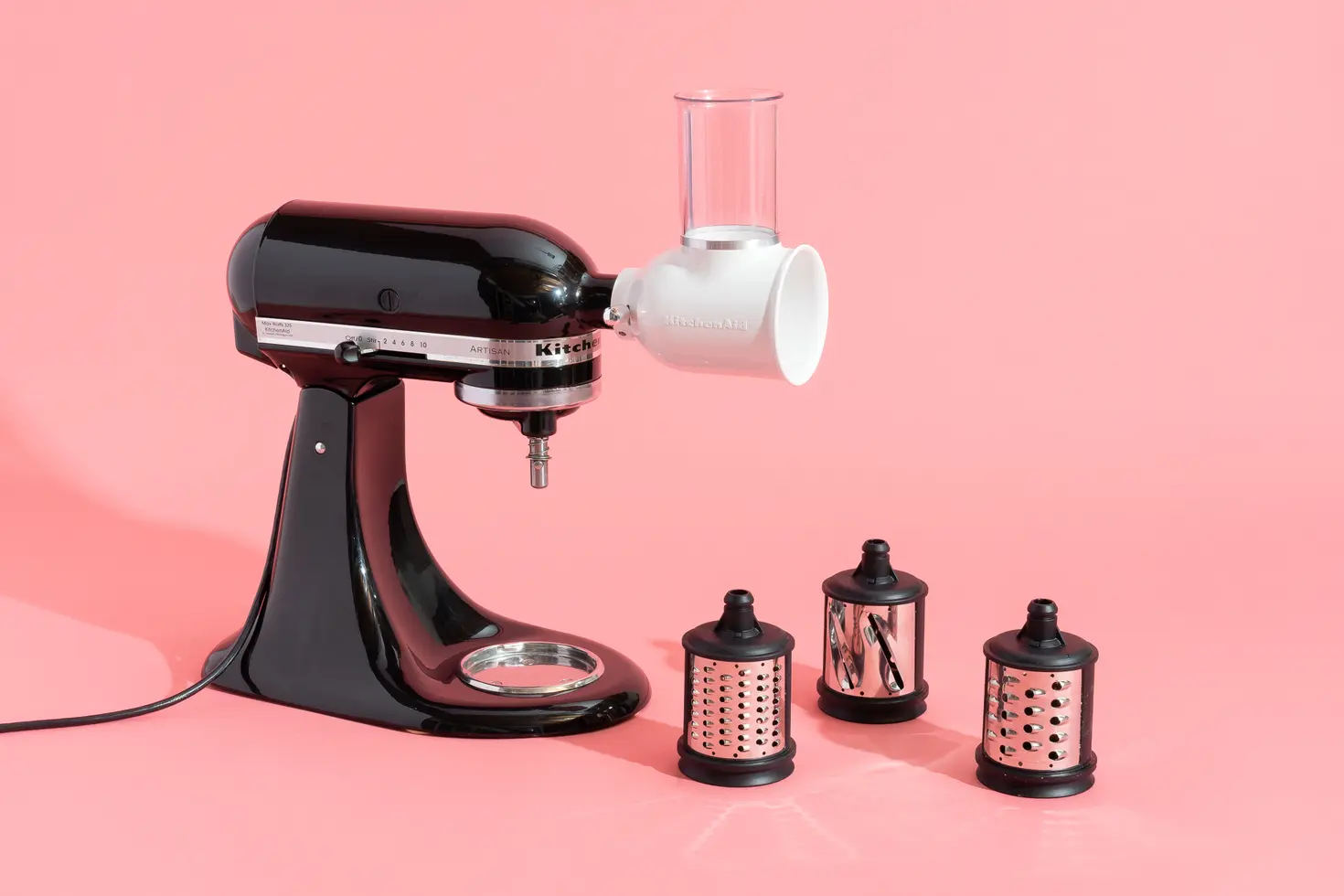
I had several issues with the KitchenAid All Metal Grain Mill, from the slow rate at which it produced flour to how messy that flour was to collect. But the thing that you’ll notice first is just how loud the attachment is. Between the sound of the grains cracking, the hum of the heavy-duty mill, and the fact that you have to run the KitchenAid at top speed for it to work, this thing creates a lot of noise.
I first tried grinding popcorn for cornbread, since the dried field corn typically used for cornmeal is incredibly hard to find in increments under 25 pounds. Starting at the largest grind, I could barely go through a cup of popcorn in 12 minutes (during which time the motor of my stand mixer started to get pretty warm, since it was running at 10). Only after milling again at a finer grind (which took another 20 minutes) did I have enough to make a batch of cornbread.
Though the included manual doesn’t mention this, a KitchenAid representative later said the mill is not meant for popcorn. Still, I had the same difficulty with wheat berries, which, at least to my eye, are as tough as popcorn. Both times, the flour from the mill went everywhere, and it was hard to collect in anything other than an upright paper bag, which could catch everything that shot off.
You really don’t gain much from the KitchenAid automation, considering the noise and poor output. You could do a lot better by getting a manual mill, such as the VKP Brands grain mill, which is a fraction of the price.
Why you should trust me
I’ve worked in food and wine since 2008, and I have used KitchenAid and other stand mixer brands professionally as a pastry student and at work in a restaurant kitchen. Last year, I invested in a KitchenAid of my own—a refurbished Pro 600. But for years before, as an avid home cook and recipe developer, I put in enough time grating, chopping, and whipping things manually to know when an upgrade really makes a difference.
How we picked and tested
KitchenAid makes over three dozen attachments for its stand mixers, but they’re not all equally vital for day-to-day use. Some, like the vegetable sheet cutter and the sifter-and-scale attachment, were a little too specific to justify testing, and we found the ice cream maker and vegetable spiralizer to be lacking in previous Wirecutter tests. From there, we narrowed the list to the five attachments with the most potential for utility: the meat grinder, the fresh prep slicer/shredder, the pasta roller, the pasta press, and the metal grain mill.
I used each attachment with my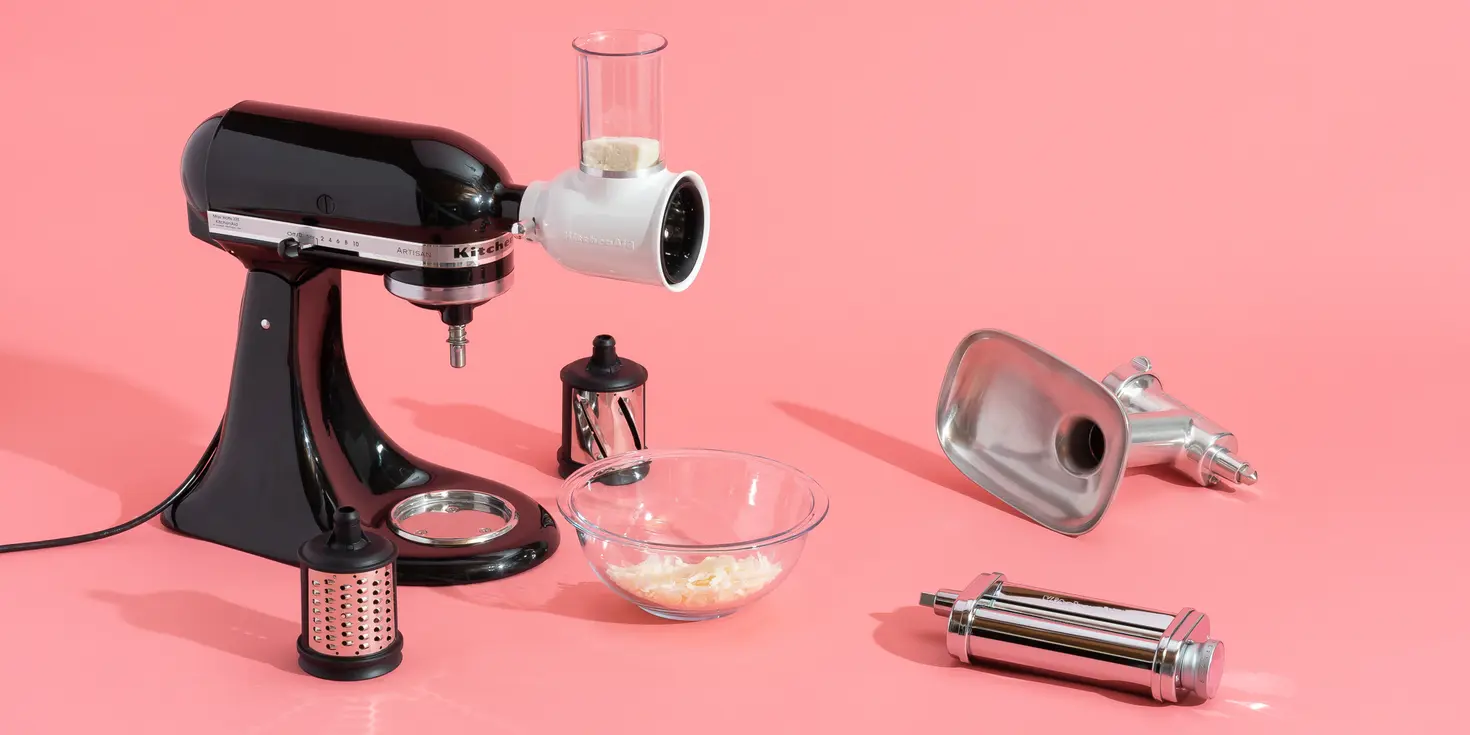
KitchenAid Pro 600 mixer, and I ran through a series of tests to experiment with all the features of each. I tested the different coarseness settings on the meat grinder and all of the shapes on the pasta press. With the shredder I grated three different textures of cheese (from soft to firm), as well as an assortment of vegetables. Each time, I asked myself whether I could see this attachment becoming a tool I would use regularly enough to warrant the space and cost, or if it would collect dust while I reached for my usual kitchen gear instead. If the appliance was bringing a new function, I considered whether it performed as well as I would expect a standalone machine to.
For weeks I used my KitchenAid almost every day: attaching the meat grinder to process a large batch of chorizo, as well as a single steak for tartare; shredding potatoes, carrots, cabbage, and three types of cheese on the rotary fresh prep slicer; and rolling yards of pasta. Some meals consisted almost entirely of attachment-produced components, like a lasagna Bolognese I made using meat, fresh pasta, and cheese that had all been processed that day.
Though I don’t mind spending six hours on an exceptional baked pasta, I understand that not everybody wants to cook like a restaurant chef. In the case of my top picks—the meat grinder and the pasta roller—they can make outsize improvements in your everyday dishes. And, unlike learning a new cooking skill or cuisine, there is only a brief learning curve to using these attachments before you can reap the rewards.
